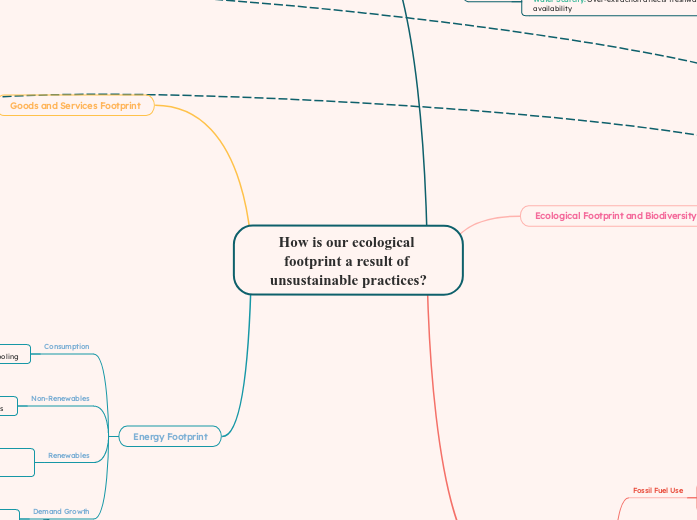How is our ecological footprint a result of unsustainable practices?
Food Footprint
Agricultural Practices
Intensive Farming: chemical use and monoculture, leading to soil degradation
Soil Degradation: Erosion, fertility loss &nutrient depletion
Food Waste
Wasted Resources: during production and distribution
Emissions from Waste: Greenhouse gases & methane
Land Use
Deforestation for Agriculture: biodiversity loss & carbon release
Forests cleared, causing habitat loss
Water Use
Agricultural Water Usage: High demand for irrigation leading to water scarcity
Water Scarcity: Over-extraction affects freshwater availability
Ecological Footprint and Biodiversity
Human Impact on Ecosystems
Clearing forests reduces biodiversity & disrupts ecosystems
Urban Sprawl: Expansion of urban areas leads to habitat fragmentation
Biocapacity Imbalance
Decreased biocapacity: loss of productive land & ecosystems due to human activity
Resource Overconsumption: Demand exceeds the Earth's capacity to regenerate
Global Trends
Developed countries: larger ecological footprints due to higher consumption & resource use
Disparities in Resource Use: Inequitable distribution of resource consumption & waste generation
Ecological Deficit
Footprint Exceeds Biocapacity: Creating an ecological deficit
Resource depletion: environmental degradation & unsustainable consumption patterns
Carbon Footprint
Fossil Fuel Use
Coal, Oil, Gas: Major contributors to carbon emissions
Electricity Generation: Extensive use of fossil fuels for power
Greenhouse Gas Emissions
CO2 Emissions: fossil fuels & industrial processes
Methane Emissions: from agriculture (livestock, rice, paddies) & waste (landfills)
Transportation Emissions
Vehicle Emissions: Cars, trucks, & airplanes
Urban Air Quality: Pollution impacts affect health
Industrial Emissions
Factory Emissions: CO2 & pollutants from manufacturing processes
Power Plant Emissions: coal-fired power plants
Goods and Services Footprint
Manufacturing Impact
Large resource consumption
Industrial pollution: air, water
Waste Generation
High levels of waste from packaging & consumer goods
Landfills & recycling systems overwhelmed by waste volumes
Resource Depletion
Over-extraction of non-renewable resources
Finite resources deplete quickly
Consumerism
Consumer demand causes overproduction
High consumption rates: increase pressure on natural resources
Energy Footprint
Consumption
Heavy reliance on energy: households and industries
Significant energy use: heating and cooling
Non-Renewables
Fossil fuel use: significant environmental harm & resource depletion
Air pollution: emissions from burning fossil fuels
Renewables
Wind Energy: Wildlife impacts, bird and bat collisions, noise pollution
Solar Energy: Requires large land areas & hazardous materials in production
Demand Growth
Increasing energy demand: urbanization & industrialization
Growing industries: require more energy
